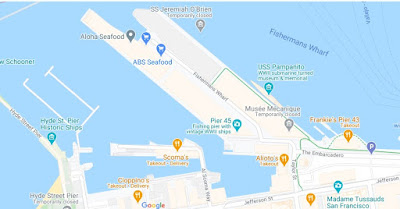In the Summer of 1950 when I was fifteen the family drove from Ohio to California to visit close relatives in Pasadena. We were treated to a weekend in San Francisco, a city this adolescent immediately fell in love with and declared to all who would listen that this was the place he wanted to live as an adult. Contributing significantly to this euphoria was finding Fisherman’s Wharf, shown below, and the seafood served there.
It was to Fisherman’s Grotto that the family hied that weekend. The dinner was delicious. I became thoroughly hooked on Grotto seafood and recall insisting on going back a second night. Same result. I never realized my dream of living in Frisco, going East instead, but as an adult transited through the city on several occasions on trips abroad, staying a night or two downtown or near the airport, never venturing anywhere near the wharf. In the meantime I heard tales that Fisherman’s Wharf had become a tourist “trap,” somewhat seedy and the food mediocre.
All that changed in 2003 when I came to San Francisco for a weeklong conference, staying in a hotel not far from the wharf area. Arriving in the city in the early morning, my cab took us up Jefferson Street right past Fisherman’s Wharf. More than a half century had passed since I had last been there and a wave of nostalgia washed over me. I had to go back.
Lucky some of my fellow conferees were of the same mind. Better yet, they knew of one of the Wharf restaurants that still had a solid reputation: Scoma’s. Shown on a map here, this eatery was opened in 1965 by Al Scoma in a small coffee shop on Pier 47 that served local fishermen breakfast and burgers. From that small beginning Scoma and his brother expanded the place into what has been called “one of the nation's highest grossing independent restaurants.”
Because it is both highly successful and relatively small, with no reservations taken, it is also difficult to get into. Often with long lines of perspective patrons stretch down Pier 47. By judicious timing of a visit, however, it is possible to endure only a relatively short wait — one well worth the trouble. That week and subsequently, whenever in San Francisco, I found my way to one of Scoma’s restaurant tables and enjoyed.
The experience also invariably casts me back those many years I first cast eyes on Fisherman’s Wharf and San Francisco, deciding then and there to make the city my future home. Instead, I will settle for looking at a few souvenirs and remember boyish dreams.















